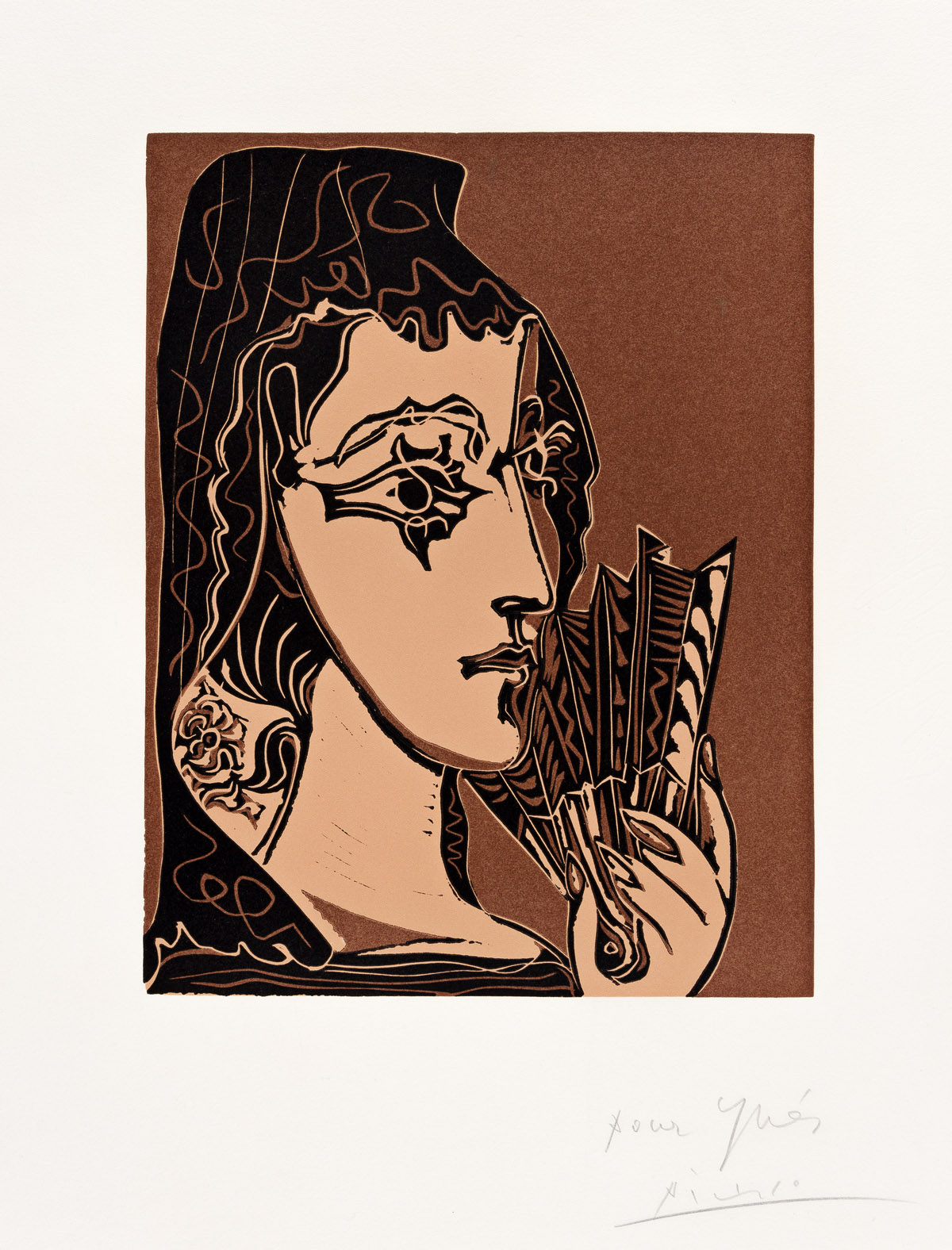Sale 2585 - Lot 352
Unsold
Estimate: $ 35,000 - $ 50,000
PABLO PICASSO
Portrait de Jacqueline en Carmen (L'Espagnole).
Color linoleum cut, 1962. 350x270 mm; 13 3/4x10 3/4 inches, full margins. Artist's proof, aside from the edition of 50. Signed and dedicated in pencil, lower right. Printed by Arnéra, Vallauris. Published by Galerie Louise Leiris, Paris. A superb, richly-inked impression with strong colors.
A letter of authentication from Yves and Marc Lebouc, Paris, October 18, 2016, accompanies this lot.
Among the more than 150 color linoleum cuts that Picasso produced during the 1950s and 1960s, none stand out for their boldness of execution and sheer artistry as much as his colorful semi-abstract portraits of his second wife, Jacqueline Roque (1927-1986). Picasso's entry to the medium of color linoleum cut coincided with his introduction to Jacqueline in the early 1950s, he had tried his hand at a few monochromatic linoleum cuts in the 1930s but never pursued the medium any further until the mid 1950s.
Abandoned by her father, Jacqueline was 18 years old when her mother died of a stroke. Following a short marriage to an engineer named André Hutin, she settled in southern France in the early 1950s and took a job at the Madoura pottery workshop in Vallauris. Picasso met Jacqueline, then 27 years old, in 1953 while he was beginning what would become a prodigious output of limited edition pottery at the Madoura workshop. Reputedly, Picasso pursued Jacqueline with a rose each day until she agreed to date him six months later. They were married in 1955, following the death of Picasso's first wife, Olga Koklova.
In these color linoleum cut portraits of Jacqueline, Picasso exaggerates her dark eyes, arching eyebrows and high cheekbones. These characteristics would become steadfast in his later portraiture. Picasso's series of paintings that derived from Eugène Delacroix's The Women of Algiers was said to be inspired by Roque's beauty. Picasso declared that "Delacroix had already met Jacqueline" on his painting her into the famous series, as was his portrait of Jacqueline as Lola de Valence, an ode to her beauty playing on Édouard Manet's iconic portrait of the famed Spanish dancer.
Jacqueline's later years with Picasso were fraught with hardship and contention. After his death in 1973 she spent years in litigation with Picasso's mistress François Gilot and his children over his estate. Sadly, she committed suicide 13 years after his death, on the eve of the opening of an upcoming exhibition of her private collection of Picasso's work in Spain. Bloch 1095; Baer 1324.
Portrait de Jacqueline en Carmen (L'Espagnole).
Color linoleum cut, 1962. 350x270 mm; 13 3/4x10 3/4 inches, full margins. Artist's proof, aside from the edition of 50. Signed and dedicated in pencil, lower right. Printed by Arnéra, Vallauris. Published by Galerie Louise Leiris, Paris. A superb, richly-inked impression with strong colors.
A letter of authentication from Yves and Marc Lebouc, Paris, October 18, 2016, accompanies this lot.
Among the more than 150 color linoleum cuts that Picasso produced during the 1950s and 1960s, none stand out for their boldness of execution and sheer artistry as much as his colorful semi-abstract portraits of his second wife, Jacqueline Roque (1927-1986). Picasso's entry to the medium of color linoleum cut coincided with his introduction to Jacqueline in the early 1950s, he had tried his hand at a few monochromatic linoleum cuts in the 1930s but never pursued the medium any further until the mid 1950s.
Abandoned by her father, Jacqueline was 18 years old when her mother died of a stroke. Following a short marriage to an engineer named André Hutin, she settled in southern France in the early 1950s and took a job at the Madoura pottery workshop in Vallauris. Picasso met Jacqueline, then 27 years old, in 1953 while he was beginning what would become a prodigious output of limited edition pottery at the Madoura workshop. Reputedly, Picasso pursued Jacqueline with a rose each day until she agreed to date him six months later. They were married in 1955, following the death of Picasso's first wife, Olga Koklova.
In these color linoleum cut portraits of Jacqueline, Picasso exaggerates her dark eyes, arching eyebrows and high cheekbones. These characteristics would become steadfast in his later portraiture. Picasso's series of paintings that derived from Eugène Delacroix's The Women of Algiers was said to be inspired by Roque's beauty. Picasso declared that "Delacroix had already met Jacqueline" on his painting her into the famous series, as was his portrait of Jacqueline as Lola de Valence, an ode to her beauty playing on Édouard Manet's iconic portrait of the famed Spanish dancer.
Jacqueline's later years with Picasso were fraught with hardship and contention. After his death in 1973 she spent years in litigation with Picasso's mistress François Gilot and his children over his estate. Sadly, she committed suicide 13 years after his death, on the eve of the opening of an upcoming exhibition of her private collection of Picasso's work in Spain. Bloch 1095; Baer 1324.

Exhibition Hours
Exhibition Hours
Aliquam vulputate ornare congue. Vestibulum maximus, libero in placerat faucibus, risus nisl molestie massa, ut maximus metus lectus vel lorem.


